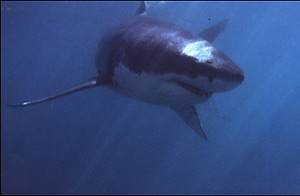|
White shark rushes across Indian Ocean in record-breaking swim
(AFP)
Updated: 2005-10-09 09:26 A female white shark has stunned scientists by
swimming from South Africa to Australia and back in record time, shattering
assumptions about how the fish migrates and navigates, according to a study.
An international team of scientists followed the female
shark after tagging a group of great white sharks living off the Western Cape of
South Africa with satellite transmitters between June 2002 and November 2003.
 The transmitters and a high-resolution photographic system allowed the
researchers to monitor the movements and listen to the murmurs of the predator
in unprecedented detail, the authors wrote in this week's issue of the US
journal Science. The transmitters and a high-resolution photographic system allowed the
researchers to monitor the movements and listen to the murmurs of the predator
in unprecedented detail, the authors wrote in this week's issue of the US
journal Science.
One of the sharks, known as P12 and nicknamed "Nicole" in honor of Australian
actress Nicole Kidman, set out on her own on an epic journey across the vast
expanse of the Indian Ocean.
"Shark P12 performed the fastest transoceanic return migration recorded among
marine fauna," the authors wrote.
Nicole swam 20,000 kilometers (12,400 miles) in a little less than nine
months, the article said. Moving at a minimum speed of 4.7 kilometres an hour
(2.9 miles an hour), Nicole's pace was similar to that of fast-swimming tuna and
"the fastest sustained long-distance speed known among sharks", the article
said.
It was unclear why Nicole chose to swim so far so fast, but the researchers
speculated that she was possibly looking for a mate.
The findings contradicted earlier assumptions that only male sharks migrated
great distances and suggested that females may travel across the ocean to mate
and then return to their original habitat to give birth.
The satellite data also indicated that there is a greater degree of
interaction than previously believed between the two main population centers for
white sharks, in South Africa and Australia.
For about two-thirds of the time, Nicole travelled at less than five meters
(yards) beneath the surface of the ocean, raising fresh questions about how
sharks navigate.
The authors of the study speculated that Nicole's ocean-surface swimming
meant sharks might be relying on "celestial clues" such as the sun or moon to
help them navigate as well as, or instead of, following gradients in the Earth's
magnetic field.
"The mechanisms used by P12 to navigate to Australia and back remain
unknown," the authors wrote.
Whatever the secret underlying the shark's natural compass, Nicole navigated
with impressive precision. Scientists found that Nicole swam in an almost
straight line instead of moving from island to island.
Photographs showed that Nicole returned to where she had begun off the South
African coast, displaying "an outstanding navigational ability".
The study, which showed sharks are travelling out of domestically protected
waters in South Africa and Australia, underlined the need for global protection
of the white shark as an endangered species, the authors
wrote.
|